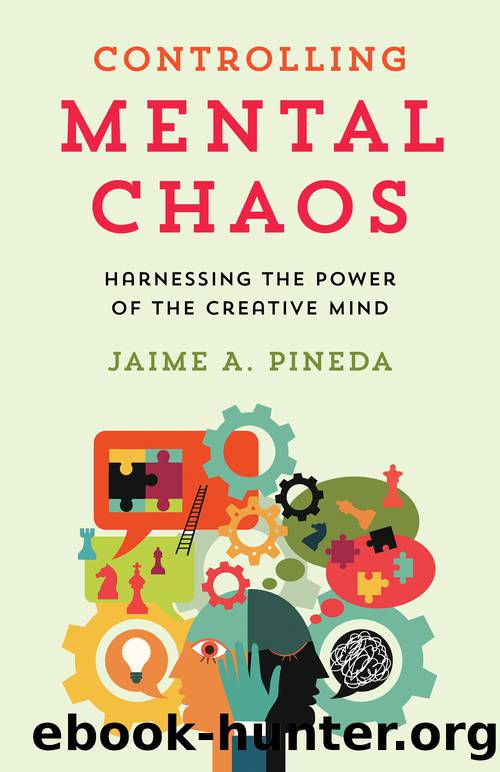Controlling Mental Chaos by Jaime A. Pineda

Author:Jaime A. Pineda
Language: eng
Format: epub
Publisher: Rowman & Littlefield Publishers
Published: 2023-04-25T00:00:00+00:00
Biased Thinking
Other major factors in the mind getting stuck in problem-solving mode are the biases in thinking that develop as we mature. Psychologists have suggested that biased thinking reflects errors in deliberation, affecting the decisions and judgments that individuals make. Biased thinking is like the heuristic functions described previously. Both biases and heuristics need memory and attentional resources. As the GPS example suggested, sometimes you think you know better than the nonconscious mind. The overconfidence may reflect the normal bias toward rational and conscious processing, which may have benefits. But overconfidence also makes life harder, for the bias can make you unable or unwilling to let go of conceptual reflection. This clinging makes change difficult, especially when what you need is to let go and let nonconscious processing resume control.
One bias related to thinking is what psychologists describe as âpositivity bias.â14 This bias occurs when adults hold themselves in higher regard than they do their peers. These individuals are of the opinion that their future is rosier than that of others and convince themselves that they are more in control of their future. Also known as the âPollyanna Principle,â it makes conscious processing biased in a positive direction, although the bias in conscious processing itself may produce Pollyanna-ish thoughts. Whichever way it goes, what is fascinating is that adults also exhibit an opposite bias called ânegativity dominance.â15 This negative bias occurs when individuals describe spontaneous, non-conscious thoughts or mental chatter negatively. Negativity may be the tendency to react more to undesirable than desirable information.
Freudâs pessimistic views of the nonconscious are another potential source of negative biases. His ideas exploded in the popular media and still hold sway for many people. It is unclear whether Freud was an astute observer of ânegativity biasâ himself or helped fuel the negativity by popularizing it. Still, another explanation for these biases comes from an evolutionary perspective. This view argues that our brain developed to detect threat-associated information and to give greater weight to negative events, objects, and personal traits. Perception of threats and of negative stimuli promotes greater survivability compared to focusing on positive events. Researchers point out that these biases and their tendencies produce ingrained habitual responses that influence the birth and maintenance of the chattering intellect. This explanation has also penetrated the popular media. Thus, whether influenced by Freudian thought, evolutionary theory, or something else, we aggravate the problem when perceptual biases combine with the natural tendency to give more weight to negative thoughts.
Implicit biases describe attitudes toward people, or the stereotypes associated with them, that occur without conscious awareness. A concerning implicit bias happens when Caucasians, even those who claim not to be racist, associate criminality with people of color without realizing they are doing it. Studies have shown that racial biases spring from primitive social biases toward strangers who do not look like you, or are unfamiliar. From an evolutionary perspective, caution about unfamiliar people makes sense. One explanation for implicit biases is that most actions occur without conscious awareness to allow smooth functioning in a very complex world.
Download
This site does not store any files on its server. We only index and link to content provided by other sites. Please contact the content providers to delete copyright contents if any and email us, we'll remove relevant links or contents immediately.
Rewire Your Anxious Brain by Catherine M. Pittman(17635)
The Code Book by Simon Singh(2247)
The Wrong McElroy by KL Hughes(2028)
How to Be Yourself by Ellen Hendriksen(1963)
No Worries by Sarah Edelman(1871)
Life After Darkness by Michelle Knight(1558)
Anxious for Nothing by Max Lucado(1423)
I Really Didn't Think This Through by Beth Evans(1421)
Unfuck Your Brain: Using Science to Get Over Anxiety, Depression, Anger, Freak-Outs, and Triggers by Faith G Harper(1403)
The Velvet Rage by Alan Downs(1394)
The Anxiety Workbook by Arlin Cuncic MA(1355)
First, We Make the Beast Beautiful by Sarah Wilson(1282)
How Not to Worry by Paul McGee(1213)
You Can Do All Things by Kate Allan(1192)
Free Yourself from Fears by Joseph O'Connor(1182)
The Worry Trick by David A Carbonell(1170)
Coping with Anxiety by Edmund Bourne & Lorna Garano(1136)
Need by Unknown(1112)
The Sensory Child Gets Organized by Carolyn Dalgliesh(1080)
